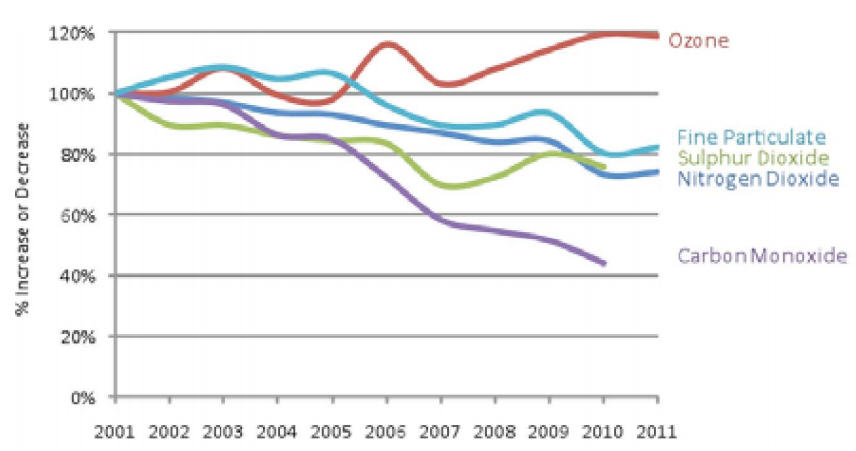Scientists from the University of British Columbia, along with state and environmental groups, are trying to figure out why average levels of ground-level ozone haven't dropped with emissions over the last decade and have instead gone up. A new report from Metro Vancouver shows ambient levels of fine particulate matter, like sulphur dioxide, nitrogen dioxide and carbon monoxide, have declined by 20 to 60 percent since 2001, but ozone has continued to rise in that same period, up 20 percent.
There's good ozone and bad ozone, of course. The protective layer of ozone in the stratosphere which protects us from the Sun's ultraviolet rays are why various pollutants, like the organic compound(1) known as chlorofluorocarbons (CFCs) that contain carbon, chlorine, and fluorine, have been banned. Ground-level ozone in the troposphere, unlike the stratospheric kind, is basically what we see as smog and is created from a combination of natural sources and nitrogen oxides in the air - it isn't emitted directly. Industry emissions and gasoline use contribute to ground-level ozone and since they are driven by sunlight and heat, ground-level ozone is a greater problem during the summer months.

Ground-level ozone - smog - should be down if contributors are down. Credit: Metro Vancouver
All those drivers are down. Why isn't ozone? Well, it is, at least compared to decades ago, when you couldn't see the mountains on a smoggy day. But it seems local efforts can only accomplish so much.
One thing that longer-term analysis of emissions problems of past decades, like the ozone layer and acid rain, can teach us is that there is no single magic bullet for the atmosphere and sometimes fixing problems in one area will lead to problems in another. Banning CFCs did not stop ground-level ozone and building a lot of batteries for electric cars will just bring back acid rain. Plus, new combustion cars of today are 90% cleaner than a car of 1970, though cars are still implicated in emissions concerns because there are more of them - banning them entirely would not actually solve anything because they are so clean now. Methane, soot and ozone levels should continue to be an area of focus (like genetically engineering cows that burp less methane) (2) but governments have a tendency to instead focus on high-profile, scientifically meaningless theater like banning fireplaces and slapping huge fees on construction companies that don't buy a new backhoe when they have a perfectly good old one. If you think the environmental cost of building a new piece of construction equipment is not greater and thus more harmful overall for Earth than the emissions of an existing old backhoe, then you deserve to breathe lousy air.
The atmosphere is pretty complex and the reasons behind changes are only simplified when voters need to be convinced. In the last meaningful page of the Metro Vancouver air quality report, before they tell us how awesome regulations are, they write
These trends have been observed over the last twenty years even though concentrations of the nitrogen oxides and volatile organic compounds that create ground-level ozone have been decreasing. Work is ongoing to understand the reasons for this. In the mean time, reducing ozone concentrations in the Lower Fraser Valley remains a priority.In other words, they have no idea why all the regulations they say are awesome have not worked. Don't get me wrong, more pollution is bad, less is good, and Metro Vancouver is to be applauded for clarity and honesty in admitting this is a puzzle. We don't want to use honesty against them, but it would seem a pocket of emissions reductions don't make a big difference.
The best guess for pollutants causing ozone is neighbors, obviously - like I said, ground-level ozone is created, not emitted. Metro Vancouver is in the Fraser Valley Regional District and borders America. But it's not the USA this time since those emissions levels are also dramatically down there. It is more likely to be coming from across the Pacific, where no efforts at cutting pollution are being implemented seriously. Clearly any climate solution that only impacts America, Canada and western nations but exempts 'developing' nations like China, India and others in Asia is doomed to fail where it matters most - fixing problems in the atmosphere.
Source: Caring for the Air - Metro Vancouver 2012
Read more:Smog disconnect puzzles Metro air quality experts by Jeff Nagel, SurreyLeader.com
NOTES:
(1) Proving once again that anti-science people obsessed with 'organic' don't actually know what the word means, or they would know how silly they sound trying to claim some food is not organic.
(2) Genetic modification of cows to burp less is not welcome by vegetarians, who like to claim meat is a global warming problem and not their cultural one, and certainly not welcome by the contingent that believes only natural modifications that occur randomly in nature are acceptable.




Comments